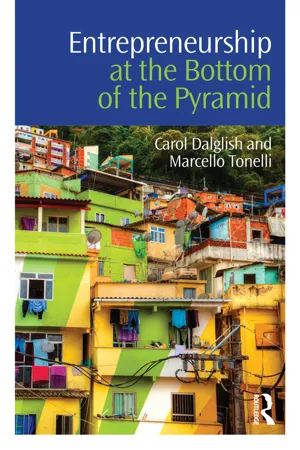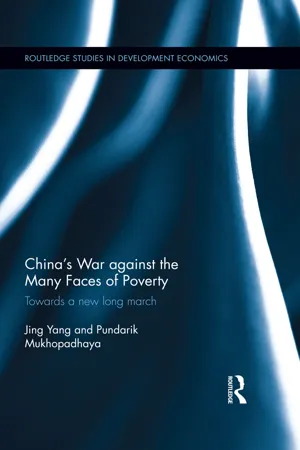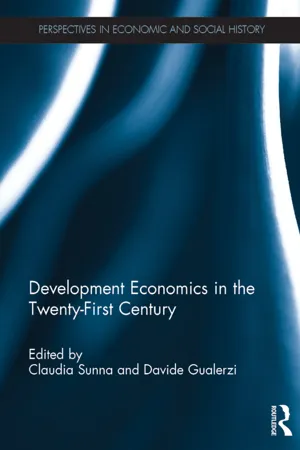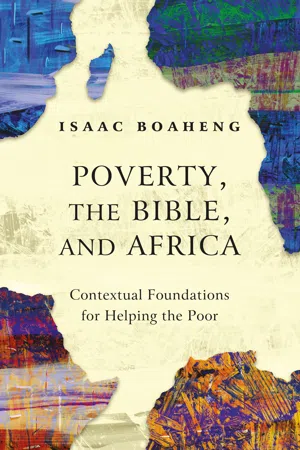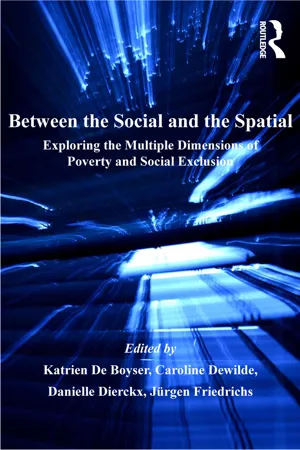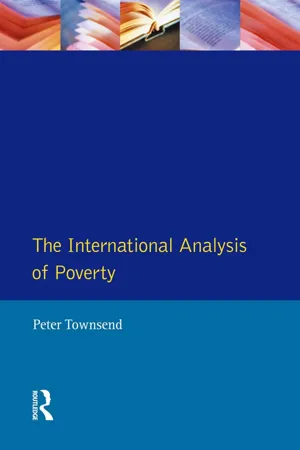Social Sciences
Types of Poverty
Types of poverty can be categorized into absolute poverty, which refers to a lack of basic necessities for survival, and relative poverty, which is defined in relation to the living standards of the society in which an individual lives. Absolute poverty is often measured by income levels, while relative poverty considers social and economic disparities within a specific community or country.
Written by Perlego with AI-assistance
Related key terms
6 Key excerpts on "Types of Poverty"
- eBook - ePub
- Carol Dalglish, Marcello Tonelli(Authors)
- 2016(Publication Date)
- Routledge(Publisher)
The Action Plan for the Reduction of Absolute Poverty articulated in Mozambique 2006–2009 (Republic of Mozambique 2006), one of the poorest countries in the world, defines poverty as “the impossibility, owing to inability and/or lack of opportunity for individuals, families and communities to have access to the minimum basic conditions, according to the society’s basic standards”. The document goes on to define different Types of Poverty: absolute, relative, transient and chronic poverty (Massingue 2013 p. 10).Absolute poverty is defined as the lack of ability to access basic nutritional and non-nutritional requirements, e.g. starving people, living without proper housing, clothing or medical care, people who struggle to stay alive. Examples from Africa, Asia and South America show that this is not a rare phenomenon.Relative poverty, as the name suggests, is context specific. It relates more to inequality, such that being poor means not having access to the prevailing living standards of the society as a whole. A society like the US, for example, has the largest number of wealthy people in the world, but also a significant number of people who struggle to find the basics of life, such as adequate healthcare, regular nutritious food and affordable housing.Both these Types of Poverty can take different forms.Transient poverty, unlike absolute or relative poverty, is concerned with the movement in and out of poverty. This can be a one-time movement into or out of poverty caused by short-term unemployment or civil unrest, or it can be intermittent where job security is frequently uncertain and the spectre of poverty often follows unemployment, particularly in urban areas. Once in poverty it can be a challenge to emerge. Because of this phenomenon, some societies, such as those in Scandinavia, have a social network that means whatever misfortune befalls the individual, the state will ensure that basic needs are met and the person, or family, is helped to re-establish themselves.Chronic poverty - eBook - ePub
- Jing Yang, Pundarik Mukhopadhaya(Authors)
- 2016(Publication Date)
- Routledge(Publisher)
Their study includes 11 indicators such as education, water and fuel. 2 This means the high growth rate did not translate into improvements by the reduction of deprivations. In brief, the monetary poverty approach describes only a single dimension and may not be an appropriate proxy for well-being. Moreover, Haushofer and Fehr (2014) pointed out that poverty may also be from psychological problems that could affect economic behaviours. Thus the understanding of poverty should be broadened from a monetary concept to a multidimensional socio-economic framework. 2.2 What are the possible dimensions? The dimensions of poverty have been discussed in the theoretical literature. The social exclusion (SE) approach (Townsend, 1979) defines poverty as exclusion from ordinary living patterns, customs and activities. 3 Haan (2001) pointed out that the social exclusion approach focused on the multidimensionality of deprivation and causal connections between dimensions. Social, political and cultural dimensions such as income, employment, housing, insurance and social isolation may all be discussed as part of the social exclusion approach (Laderchi et al., 2003). Furthermore, the sustainable livelihoods (SL) approach (Chambers and Conway, 1992) defines poverty as a lack of sufficient livelihood to satisfy needs or gain a living. Livelihood is identified as the capabilities, assets such as stores, resources, claims and access and activities required for a means of living (Chambers and Conway, 1992). 4 Obviously, the multidimensionality aspect is also emphasised in the sustainable livelihoods approach - Claudia Sunna, Davide Gualerzi(Authors)
- 2015(Publication Date)
- Routledge(Publisher)
21The most relevant research lines at the inception of the twenty-first century definitely take distance from the harmonious view on economic development and directly focus on enduring poverty within countries. The approach in terms of ‘poverty traps’ emphasizes the strength of self-reinforcing mechanisms, which cause poverty to persist across time.22 Many explanations for a society being kept in a ‘poverty trap’ have been put forward.23 The various research lines are fastened together by sharing the analytical concepts of ‘multiple equilibria’ and ‘path dependence’. As for the first, the underlying principle is that the given initial conditions will determine a particular equilibrium position: a too low index of life expectancy in the population of LDCs often discourages people to save, which makes it impossible that an initially low capital stock could reach the size to make the process of economic growth sustainable.24 As for the second, history matters: whenever given initial conditions lead to an outcome which in turn reinforces the traditional factors of development, a steady-state equilibrium establishes in the economy.7.3 Measures of absolute and relative povertyStarting from the second half of the 1980s, development theory eventually turned to systematic analyses of the condition of the poor as a separate topic with respect to income inequality. In a path-breaking contribution, Atkinson warned governments about the need for an informed decision on the poverty line and the appropriate index of poverty to be used for policy aims.25 The degree of poverty is defined according to two basic measurement concepts:1 Absolute poverty- eBook - ePub
Poverty, the Bible, and Africa
Contextual Foundations for Helping the Poor
- Isaac Boaheng(Author)
- 2020(Publication Date)
- HippoBooks(Publisher)
[13]The Social Exclusion Approach
The social exclusion approach is the third perspective on understanding poverty. The social exclusion that poverty brings may be in the form of “either economic dimension (exclusion from the labor market opportunities to earn income) or a purely social dimension (exclusion from decision-making, social services, and access to community and family support).”[14] This approach to poverty emerged in France in the 1970s and 1980s as a means of explaining the precarious situation of the disadvantaged and marginalized due to their inability to take part in the major economic, political, and social enterprises.[15] The meaning of the expression “social exclusion” has metamorphosed over the years.[16] In the 1970s many people became unemployed due to decline in business activities. In such a context, the term exclusion was used to denote the process that led to the expulsion of people from the job market. In the 1990s, prevalent human rights issues led to defining “excludees” as those who are “partly or completely outside the effective scope of human rights.”[17]The social exclusion approach differs from the economic and capability deprivation approaches in that the latter focus on individual characteristics and circumstances while the former shifts attention to the relational quality of life (its social dimension). According to the exclusion approach, one may have high income and still be poor if there is lack of social order and hence, insecurity in the community. Moreover, the analysis of exclusion involves the study of societal structure and the conditions of the marginalized groups, such as minority groups and the landless. Social exclusion therefore involves cultural, institutional and social dimensions, which are absent in the first two approaches. It advocates for the need to redistribute opportunities and resources in order to improve the lives of the marginalized. - eBook - ePub
Between the Social and the Spatial
Exploring the Multiple Dimensions of Poverty and Social Exclusion
- Katrien De Boyser, Jürgen Friedrichs, Caroline Dewilde(Authors)
- 2016(Publication Date)
- Routledge(Publisher)
The specific position of children justifies a careful poverty analysis based on alternative approaches. Following Sen’s seminal work on the capability approach (1976), the field of multidimensional poverty measurement has seen a wide expansion including basic needs approaches (Streeten 1981; 1984) or social exclusion methods (Marlier, Atkinson et al. 2007). Recent child poverty studies have also focused on more multidimensional aspects of poverty (Gordon, S. et al. 2003a; Bradshaw, Hoelscher et al. 2006).The comparison between monetary and multidimensional concepts has been the subject of previous research. Whilst some scholars have focused on the underlying conceptual and theoretical foundations of poverty measures (Sen 1976; 1982; Nussbaum 1992; 1993; Ravallion 1994; 2000; Ruggeri Laderchi, Saith et al. 2003; Thorbecke 2008), others have analysed poverty measurement from an empirical or applied perspective, largely focusing on the investigation of similarities or differences of poverty outcomes using different Types of Poverty measurement (Klasen 2000; Perry 2002; Baulch and Masset 2003; Bourguignon and Chakravrty 2003; Bradshaw and Finch 2003; Bastos, Fernandes et al. 2004). Findings in these studies generally suggest that the use of monetary and multidimensional poverty measures results in different pictures of poverty, pointing towards modest, if not very limited, overlap in results (Klasen 2000; Perry 2002; Baulch and Masset 2003; Bastos, Fernandes et al. 2004; Whelan, Layte et al. 2004).The development of a multidimensional poverty measure requires decisions to be made, each subject to their own advantages and disadvantages. Inherent to the construction of a multidimensional poverty measure are choices related to domains and indicators (Klasen 2000; Alkire and Foster 2008; Roelen, Gassman et al. 2008), which are often based on value judgments and context-specificity, making multidimensional poverty estimates susceptible to misinterpretation (Roelen, Gassman et al. 2009) and controversy (Klasen 2000). Other contentious issues that need to be tackled when constructing a multidimensional poverty measure include the weighting scheme for domains and indicators, as well as the construction of an aggregate poverty index (Klasen 2000; Atkinson 2003; Nolan and Whelan 2007). - eBook - ePub
- Peter Townsend(Author)
- 2014(Publication Date)
- Routledge(Publisher)
The essence of the approach I am endeavouring to develop is that society, and especially the state, is creating or ‘manufacturing’ as well as reconstituting needs at the same time as it is determining the allocation of resources in the first place (and not just the redistribution of income) with which those needs can or will be met. Our understanding of changes in the extent of poverty depend fundamentally on scientific exposition of this dual process.Absolute poverty
This brings me to a more direct discussion of Professor Sen's grounds for retaining an ‘absolute’ core to the meaning of poverty. Professor Sen has made a big contribution to the recent discussion of poverty (see references set out in Sen, 1992 , pp. 180–90). His expertise is rooted in Third World economies, especially that of India, and he has gradually extended his work to include comparisons with highly industrialised societies. In his major work Poverty and Famines he traces the analytical shift towards ‘relative deprivation’ as a driving concept in conceptions of poverty and yet resists abandonment of the idea of ‘absolute’ need or deprivation in the misguided belief that this is the only way of maintaining a central place for malnutrition in the conception of poverty. He writes:Poverty is, of course, a matter of deprivation. The recent shift in focus — especially in the sociological literature — from absolute to relative deprivation has provided a useful framework of analysis…. But relative deprivation is essentially incomplete as an approach to poverty, and supplements (but cannot supplant) the earlier approach of absolute dispossession. The much maligned biological approach, which deserves substantial reformulation but not rejection, relates to this irreducible core of absolute deprivation, keeping issues of starvation and hunger at the centre of the concept of poverty (Sen, 1981 , p. 22).Stung by different theoretical approaches developed in other work published at about the same time as his book he entered the fray more openly in his Geary Lecture, delivered in September 1982, published in a revised form in 1983. ‘There is, I would argue, an irreducible absolutist core in the idea of poverty’ (Sen, 1983 p. 159). He argues along very familiar lines ‘If there is starvation and hunger, then — no matter what the relative picture looks like — there clearly is poverty.’ What he calls the ‘relative picture’ (what to most of us would then be implied as other needs) have ‘to take a back seat behind the possibly dominating absolutist consideration’ (p. 159). I find this passage wholly unacceptable. He does not say anything about the scientific criteria by which we identify, or prioritise, human needs. In observations of behaviour in every society the drive to satisfy hunger sometimes takes second place to other drives, especially those which are conditioned by other people's expectations or because of an inculcated sense of obligation in the work place or at home, or through sheer coercion. I also find it a little significant that Professor Sen does not stick to ‘starvation’ but adds ‘and hunger’. This opens the door to a great deal of ambiguity and discussion. The scientific literature demonstrates that exact criteria, and certainly clinical criteria, are not always easy to find for the condition of ‘starvation’ but ‘hunger’ is even more open to wide interpretation and is demonstrably a relative and social concept. On the evidence of reviews such as Evason (1980) in Northern Ireland and Burghes (1980)
Learn about this page
Index pages curate the most relevant extracts from our library of academic textbooks. They’ve been created using an in-house natural language model (NLM), each adding context and meaning to key research topics.
